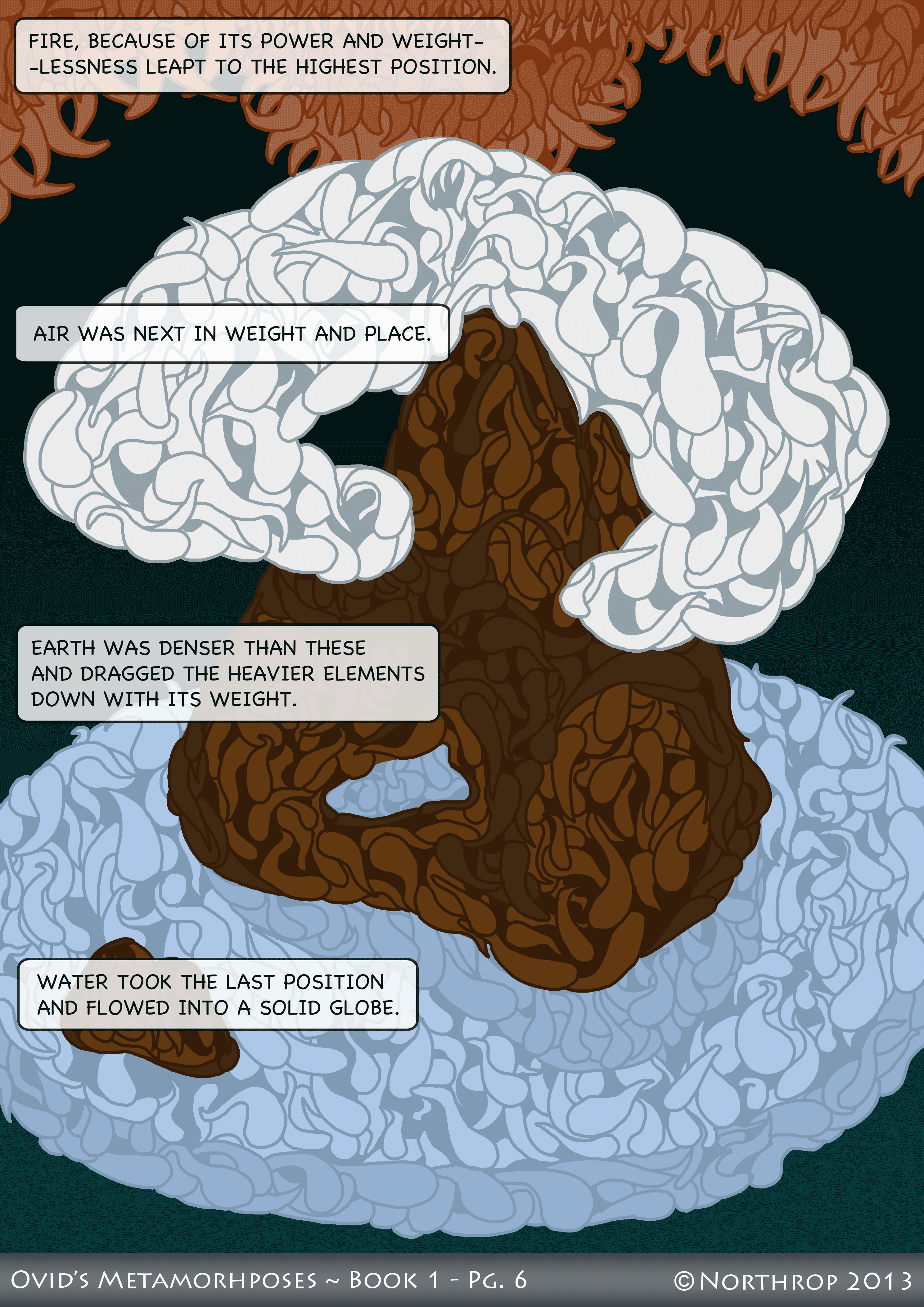Met. 1.26-31 – The Distribution
IGNEA CONVEXI VIS ET SINE PONDERE CAELI
EMICUIT SUMMAQUE LOCUM SIBI FECIT IN ARCE;
PROXIMUS EST AER ILLI LEVITATE LOCOQUE;
DENSIOR HIS TELLUS ELEMENTAQUE GRANDIA TRAXIT
ET PRESSA EST GRAVITATE SUA; CIRCUMFLUUS UMOR
ULTIMA POSSEDIT SOLIDUMQUE COERCUIT ORBEM.
AND THE WEIGHLTESS, FIERY FORCE SPRANG FORTH
AND MADE ITS PLACE IN THE HIGHEST CITADEL IN THE VAULT OF HEAVEN;
NEXT TO IT, IN WEIGHT AND PLACE, WAS THE AIR;
DENSER THAN THESE, EARTH DREW THE WEIGHTIER ELEMENTS DOWN
AND WAS PRESSED BY ITS HEFTINESS; WATER, FLOWING IN A CIRCLE,
SEIZED THE LAST PLACE AND ENCOMPASSED THE SOLID GLOBE.
Here the line between reality and allegory begins to blur; thus I thought the moment was ripe for a little animation. I’m not very good at these things, but I definitely get a strong sense of motion and fluidity from the titular metamorphoses of Ovid’s poem. So, I hope to include more animations as appropriate for future transformations.
Speaking of which, some of you may be wondering – and may have even been wondering since page 2 – about the whole “transformation” aspect of the cosmogony. Is it a metamorphosis? Where are the girls turning into trees? Well, the truth is that Ovid’s design for his cosmos is carefully chosen to fit the theme; he could have chosen to depict a creation more like Hesiod’s (in Theogony), wherein the universe is born within Χαος (“chaos” in Greek means a “yawning void” or “chasm”). But, instead, he chose to depict Chaos as a heap of matter – he then proceeds on a long, drawn out description of the restructuring of this matter. The constituent parts all morph themselves into the world we know today (such an explanation for the way things are today is known as an “aetiology”; Hellenistic writers, and most definitely Ovid are quite fond of them). Thus, the cosmogony is precisely a metamorphosis – the primal metamorphosis: it is the transformation of Chaos into Cosmos.
Finally, you’ll notice I decided to go for a flat world depiction. It is always hard to conceive of how Ovid would have thought of the Earth, especially because he is working within a tradition of mythology that stretches way back into a primeval time when all manner of descriptions of the shape of the world existed. However, he does use the Latin word “orbem”, implying roundness, even spherical-ness. The description is murky, but will be elaborated as the world continues to tape shape in the following lines…

I like the project!! On “summa” (NB long ‘a’) I assume you meant to say it agrees with “arce”?
Oh, yeah, thanks for catching that. I guess I had a little brain fart; this is what I get for translating while running to catch a bus…
It’s fixed now.
A friend posted a link to you comic on Facebook, and I’m glad they did. This is a great way to present Ovid’s Metamorphoses. I’m looking forward to seeing it continue, and will definitely be checking back weekly.
I’m so glad you enjoy it! Thanks for reading 🙂
What do you think of the strong Lucretian echoes in the cosmogony (even to the point of having fire move itself)?